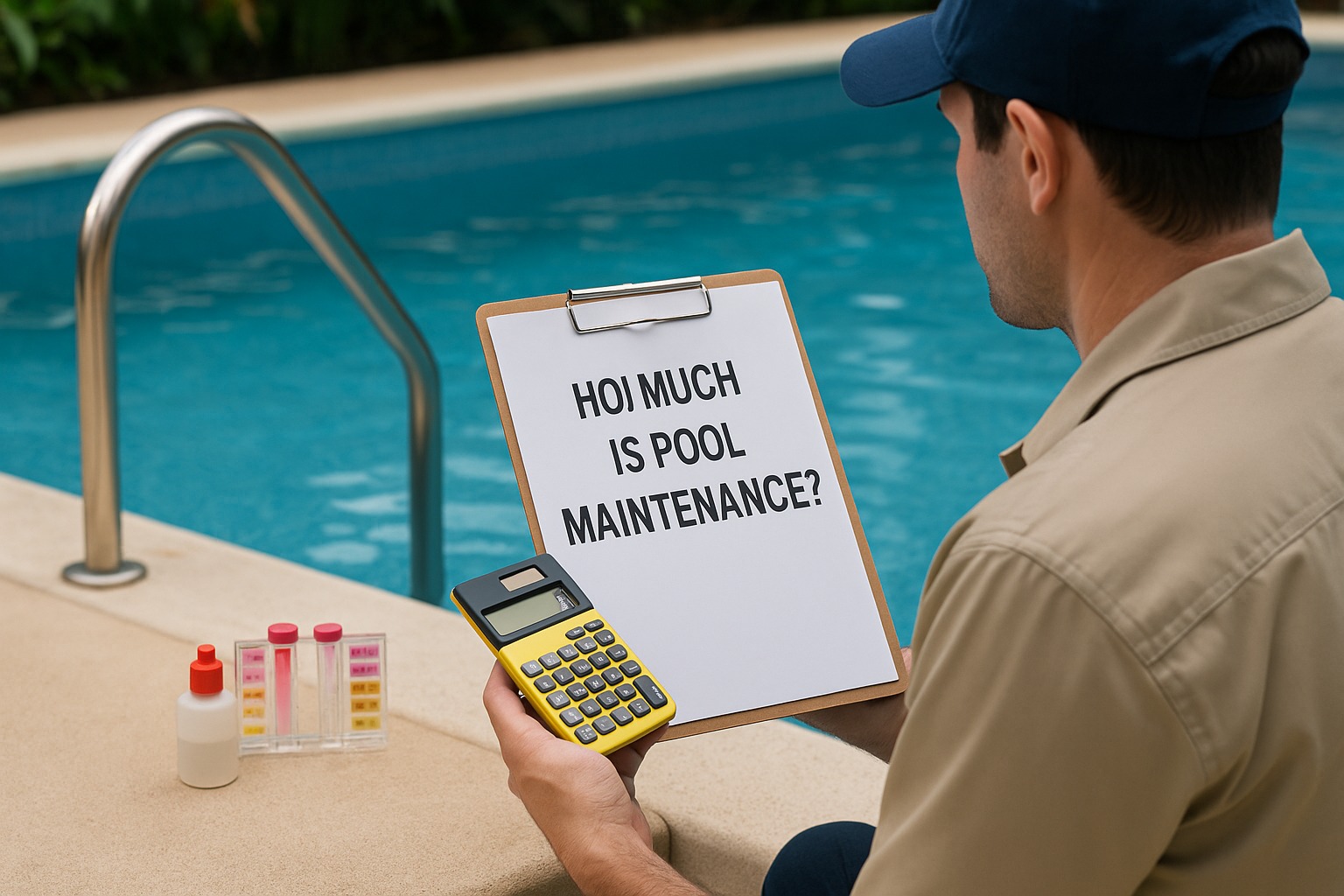Owning a swimming pool is a dream for many families, but most people don’t think about the upkeep until the bills start coming in. Pool maintenance is more than just keeping the water looking clear — it’s about protecting your investment, making sure the water is safe for your family, and keeping your equipment running smoothly for years. Knowing how much pool maintenance costs upfront helps you set a realistic budget, avoid surprises, and enjoy your pool without stress.
On average, homeowners can expect to spend $80–$150 per month if they handle basic care themselves, and around $1,000–$3,000 per year for professional service, depending on the size, type, and location of the pool. These numbers can go up or down depending on how often the pool is used, the weather in your area, and the type of equipment you have.
This guide is written for new pool owners, parents managing family pools, and anyone considering installing a pool. I’ll walk you through the real costs, what affects them, and practical tips from my own experience as a technician so you know exactly what to expect.
- Key Factors That Determine Pool Maintenance Costs
- How Much Pool Maintenance Costs: Monthly, Annual & By Type
- Typical Components Of Pool Maintenance & Their Costs
- DIY Vs Professional Maintenance: Cost, Pros & Cons
- Ways To Save Money (But Maintain Quality)
- Regional & Local Cost Examples / Case Studies
- Expert Insights & Personal Experience Tips
- Conclusion
Key Factors That Determine Pool Maintenance Costs
When customers ask me, “How much is pool maintenance?”, my answer always starts with: “It depends.” The reason is simple — no two pools are the same. The cost is shaped by several factors that directly affect how much time, effort, and product you’ll need. Let’s break down the main ones:
Pool Type & Material
- Concrete pools: These are durable but require more care. They often need acid washing every few years, and the porous surface can harbor algae, which means higher chemical use.
- Vinyl liner pools: Less expensive to maintain day-to-day, but liners can tear and need replacement every 7–10 years.
- Fiberglass pools: Smooth surfaces make cleaning easier, and they generally need fewer chemicals compared to concrete.
From experience, I tell clients that fiberglass usually saves the most on yearly chemical costs.
Size, Shape & Depth
A larger pool means more gallons of water to balance, more chemicals, and longer run times for pumps and filters.
- Small pools (10,000–15,000 gallons): Lower monthly chemical and electricity costs.
- Large pools (25,000–40,000+ gallons): Can double or triple the cost of upkeep.
Odd shapes with lots of steps and curves may also need extra brushing and circulation adjustments, which adds to labor.
Climate, Location & Weather
- In warm, sunny regions, pools run year-round. This means continuous chemical use and higher energy bills for pumps and heaters.
- In cold climates, seasonal closing and opening add upfront costs, but you’ll spend less during winter downtime.
- Rainy areas mean more dilution of chemicals, while windy spots bring in debris, which increases cleaning needs.
Usage Intensity & Features
The more swimmers you have, the faster chlorine gets used up. Families with kids using the pool daily will see higher chemical bills than a couple who swim occasionally.
Added features also raise costs:
- Heaters and spas = more energy consumption
- Waterfalls and lighting = higher electricity use and more complex equipment care
- Automatic covers = lower chemical use but extra upfront maintenance if they break
Equipment & Technology
The age and efficiency of your system make a big difference.
- Single-speed pumps cost more in electricity than variable-speed pumps, which can save hundreds per year.
- Older filters may need frequent backwashing or replacement parts.
- Smart systems (automated chlorinators, chemical sensors) cost more upfront but often reduce long-term chemical waste.
Local Labor, Utility & Chemical Costs
Even two identical pools in different cities will have different costs. Why?
- Electricity rates vary.
- Water is more expensive in some regions.
- Labor costs for technicians differ by location.
- Chemical prices can fluctuate depending on local suppliers.
Expert Tip: When budgeting, don’t just look at national averages. Always consider your specific pool type, local climate, and whether you’ll handle the work yourself or hire a pro.
How Much Pool Maintenance Costs: Monthly, Annual & By Type
Now that we know the factors, let’s get into the numbers. Pool maintenance costs aren’t one-size-fits-all, but I’ll break it down in the same way I explain to my clients — monthly, annual, and by type of pool.
Monthly Cost Breakdown
- DIY Maintenance:
If you’re handling the basics yourself (testing water, adding chemicals, cleaning), expect to spend around $80–$150 per month on supplies. This includes chlorine, pH balancers, algaecide, and test kits. - Professional Service:
Hiring a pool company typically ranges from $100–$300 per month. That covers weekly visits, water balancing, cleaning, and routine checks. Premium services that include equipment inspection and emergency callouts can be higher.
Most families I work with settle into the $150–$200/month range if they use professional help.
Annual Cost Estimates
When you add it all up:
- DIY Owners: Around $1,000–$1,800/year, depending on pool size and local chemical prices.
- Professional Service Clients: Around $1,500–$3,500/year.
These numbers include chemicals, cleaning, filter media replacement, and a few minor repairs. Big repairs like pump replacement or resurfacing are extra.
Cost By Pool Type / Material
- Concrete Pools: Highest long-term cost. They often need more chemicals, electricity, and resurfacing every 10–15 years.
- Vinyl Pools: Lower daily chemical use, but liner replacement (around $3,000–$5,000) every 7–10 years adds up.
- Fiberglass Pools: Generally the cheapest to maintain thanks to smooth surfaces and fewer chemical needs.
From real jobs, I’ve noticed fiberglass owners usually save 15–25% annually compared to concrete pool owners.
Cost By Frequency / Level Of Service
- Weekly Full Service: $125–$200/month (most common choice).
- Bi-Weekly Service: $80–$120/month (good for lower-use pools).
- Premium Contracts: $250–$400/month (includes detailed inspections, specialty chemicals, and extended warranties).
To put it simply, most pool owners will spend somewhere between $1,200 and $3,000 per year on maintenance. That’s the realistic range I see across different clients.
Typical Components Of Pool Maintenance & Their Costs
When people hear “pool maintenance,” they usually think of chlorine and a net for leaves. In reality, there are several moving parts — chemicals, cleaning, utilities, and equipment — all of which add up. Here’s a clear breakdown:
Chemicals & Water Treatment
Chemicals are the backbone of safe, clean pool water.
- Chlorine or Salt: $20–$50/month for chlorine tablets or $200–$800/year for salt cell electricity and occasional salt refills.
- Balancing Chemicals (pH up/down, alkalinity increaser, calcium hardness): $15–$30/month.
- Algaecide & Specialty Chemicals: $10–$30/month depending on the season and usage.
- Shock Treatments: About $5–$10 per shock, usually done weekly in peak summer.
In total, expect $400–$800 per year on chemicals alone.
Cleaning & Routine Tasks
- Manual Skimming & Brushing: Free if you do it yourself, but takes 1–2 hours per week.
- Vacuuming: Manual vacuums cost $200–$400; robotic vacuums run $800–$1,500 but save labor long term.
- Professional Cleaning Services: Around $75–$150 per visit.
Many of my clients invest in a robotic vacuum — upfront cost is higher, but it cuts down weekly cleaning bills.
Utility Costs
- Electricity for Pumps & Filters: $30–$80/month, depending on pump type and local rates.
- Heating (Gas or Electric): $100–$300/month in cooler climates when the heater runs often.
- Water Top-Ups: $50–$150/year for evaporation and splash-out refills.
Equipment Maintenance & Replacement
- Pump Replacement: $800–$1,500 every 8–12 years.
- Filter Media (sand, cartridges, DE): $50–$400 depending on type, replaced every 1–5 years.
- Salt Cell: $700–$1,200 every 5–7 years.
- Heater Maintenance/Replacement: $2,000–$4,000 every 10–15 years.
Seasonal & Special Tasks
- Opening the Pool (Spring): $200–$400 for professional service (chemicals, cleaning, inspection).
- Closing the Pool (Winter): $150–$300 (draining lines, covering, adding winter chemicals).
- Acid Wash (Concrete Pools): $300–$700 every 3–5 years.
- Resurfacing (Concrete): $7,000–$10,000 every 10–15 years.
- Liner Replacement (Vinyl): $3,000–$5,000 every 7–10 years.
Hidden / Unexpected Costs
- Leaks & Repairs: Can range from $200 for patch jobs to $2,000+ for major plumbing issues.
- Insurance & Safety Features: Many states require fences, alarms, or covers, which add to upfront costs.
- Local Permits & Inspections: Occasionally needed for upgrades or major repairs.
Expert Note: Regular, small maintenance prevents these hidden costs. I’ve seen homeowners ignore $20 chemical treatments only to spend thousands fixing an algae bloom or replacing damaged equipment later.
DIY Vs Professional Maintenance: Cost, Pros & Cons
The biggest decision for pool owners is whether to roll up their sleeves or pay a technician. Both approaches have advantages, but the right choice depends on your budget, time, and comfort level with chemicals and equipment.
What You Can Do Yourself
Plenty of maintenance tasks are simple and manageable if you don’t mind spending some time each week:
- Skimming & Brushing: Removes leaves and prevents algae growth.
- Testing Water: Using strips or kits to check chlorine, pH, and alkalinity levels.
- Adding Chemicals: Balancing the water weekly to keep it safe and clear.
- Vacuuming: With manual or robotic cleaners.
Cost Impact: You’ll spend about $80–$150/month on supplies. The main “cost” is your time — usually 1–2 hours per week.
When To Hire Professionals
A pool technician brings more than just convenience — they know the signs of bigger problems before they get costly. You should consider hiring a service if:
- You don’t have the time to commit weekly.
- You’re uncomfortable handling chlorine and chemicals.
- You have complex systems like saltwater generators, heaters, or automation.
- Your pool is large or used heavily by family and guests.
Cost Impact: Professional service averages $100–$300/month, but you get peace of mind and regular inspections included.
Sample Cost Comparison
Let’s take a 15,000-gallon in-ground pool as an example:
- DIY Owner: Spends roughly $1,200/year on chemicals, tools, and utilities.
- Professional Service: Spends around $2,400/year for full-service visits.
That’s a difference of about $100/month, which some homeowners consider well worth it to save their time and avoid costly mistakes.
Expert Takeaway: If you enjoy hands-on work and want to save money, DIY is perfectly doable. But if you’d rather have guaranteed water quality and equipment safety without the hassle, hiring a pro is worth the investment.
Ways To Save Money (But Maintain Quality)
Pool care doesn’t have to drain your wallet if you make smart choices. Over the years, I’ve seen small changes in equipment and habits save pool owners hundreds of dollars each season.
Invest In Energy-Efficient Equipment
- Variable-Speed Pumps: They use up to 70% less electricity than single-speed pumps. The upfront cost is higher, but most owners earn the difference back within 2–3 years.
- Efficient Heaters: Solar or heat-pump systems can dramatically cut gas or electric bills if you use your heater often.
Use Smart Monitoring Tools
Digital testers and smart sensors help track chemical levels and notify you before things get unbalanced. This reduces wasted chemicals and avoids expensive “shock fixes.”
Maintain Consistently To Avoid Repairs
The biggest money-saver is prevention. Skimming, testing water weekly, and cleaning filters keep your system healthy. I’ve seen neglected pools cost owners thousands in repairs — simply because routine care was skipped.
Use Covers & Protection
- A solar cover reduces evaporation, saving on water and heating costs.
- Safety covers keep debris out, lowering chemical use and cleaning time.
Buy Chemicals Smartly
- Purchase in bulk at the start of the season for better prices.
- Compare local supply stores with online options.
- Avoid unnecessary “fancy” chemicals — stick to the basics unless your technician recommends otherwise.
Off-Season Preparation
If you live in a colder climate, closing the pool correctly saves a lot in spring. Winterizing with the right chemicals and cover prevents damage, algae blooms, and costly repairs when reopening.
Pro Tip: Don’t cut corners on essentials like chlorine or pump runtime. Saving $30 today can cost you $300 tomorrow if your pool turns green or your pump burns out.
Regional & Local Cost Examples / Case Studies
When clients ask me “how much is pool maintenance?”, I always explain that the answer depends on their location. Climate, labor rates, and utility prices all affect the final bill. Here are some regional examples based on industry averages and what I’ve seen in the field.
U.S. / North American Averages
- Warm Southern States (Florida, Texas, Arizona):
Pools run almost year-round. Homeowners spend around $2,000–$3,000 annually due to longer pump times, higher chemical use, and the need for regular cleaning. - Northeast & Midwest:
Pools are seasonal, so yearly maintenance is lower — about $1,200–$2,000 annually. However, you’ll need to budget for professional opening and closing services each year. - West Coast (California):
Water costs are higher, and environmental rules may add extra fees. Expect around $1,500–$2,500 annually.
Hot Vs Cold Climate Comparison
- Hot Climates:
More sun exposure means chlorine burns off faster, so chemical bills are higher. Debris from storms and dust also raises cleaning frequency. - Cold Climates:
You’ll pay for winterizing, but you save on electricity and chemicals for several months while the pool is closed.
International Costs (Brief Overview)
- Australia: Pools are common in backyards, with average annual costs of $1,500–$2,500 AUD, depending on climate.
- UK & Europe: Indoor or covered pools are more common, and heating is a major expense. Maintenance can range widely — around £1,000–£3,000 annually.
Real Client Example (Case Study)
One of my clients in Dallas, Texas spends about $220/month on full-service maintenance for a 20,000-gallon saltwater pool. Another client in Chicago, Illinois, with a similar-sized chlorine pool, spends about $120/month during summer — but also pays $500/year for professional opening and closing.
This shows how location and climate make a big difference.
Expert Insights & Personal Experience Tips
Over the years, I’ve seen one common mistake: pool owners underestimate the small stuff. Skipping a weekly water test or putting off filter cleaning might not seem like a big deal, but it adds up. I’ve walked into pools that went green overnight because chemicals were out of balance for just a week — the fix cost the homeowner hundreds in shock treatments and service calls.
Here are my best technician tips:
- Stay consistent: Regular care is cheaper than emergency fixes.
- Don’t overuse chemicals: More isn’t better. Follow test results, not guesses.
- Invest in quality equipment: A variable-speed pump or robotic vacuum pays for itself within a few seasons.
- Build a relationship with a pro: Even if you do most of it yourself, having a trusted technician for inspections once or twice a year can save you from major repairs.
Conclusion
So, how much is pool maintenance? On average, expect to spend $80–$150 per month if you handle it yourself, or $100–$300 per month with a professional. That works out to $1,200–$3,000 annually for most homeowners. The final cost depends on your pool’s size, type, location, and how much work you’re willing to do yourself.
The good news is, with smart planning and consistent care, pool maintenance doesn’t have to feel overwhelming or overly expensive. By understanding the factors that affect cost, budgeting realistically, and following expert-backed tips, you’ll keep your water sparkling, your equipment in good shape, and your family safe — without surprises on your bill.
Owning a pool is an investment in your home and your lifestyle. With the right approach, you can enjoy it stress-free, knowing exactly what to expect year after year.
FAQ’s:
How Much Does Pool Maintenance Cost Per Month?
For most homeowners, monthly pool maintenance costs fall between $80 and $150 if you do it yourself, and $100 to $300 if you hire a professional service. The exact number depends on pool size, type, and local rates.
How Much Maintenance Is A Swimming Pool Annually?
On average, you’ll spend $1,200 to $3,000 per year on routine care. That covers chemicals, utilities, and basic equipment upkeep. Major repairs like resurfacing or pump replacement are extra and should be budgeted separately.
Is It Cheaper To Maintain A Pool Yourself?
Yes — handling the basics yourself saves money, but it also takes 1–2 hours a week of hands-on work. Many families find the convenience and expertise of a professional worth the extra cost, especially if they’re busy or have large, complex pools.
What’s The Lifespan Of Pool Equipment?
- Pumps: 8–12 years
- Filters: 5–10 years (media replaced more often)
- Heaters: 10–15 years
- Salt cells: 5–7 years
- Vinyl liners: 7–10 years
- Concrete surfaces: 10–15 years before resurfacing
Taking care of your system with regular cleaning and balanced water can extend these lifespans significantly.
Can I Predict And Budget Pool Maintenance Costs Accurately?
Mostly, yes. If your pool is in good condition and you follow consistent care, your yearly costs won’t fluctuate too much. The main unpredictable expenses are unexpected repairs (like leaks or motor failures). A good tip is to set aside an extra $200–$400 per year as a “just-in-case” pool fund.
Thank you for visiting our Blog! For more engaging content, please check out the related category.
Disclaimer:
This article is for informational purposes only and reflects general estimates of pool maintenance costs. Actual expenses may vary depending on location, pool type, and service provider. Always consult a licensed pool technician for personalized advice.





